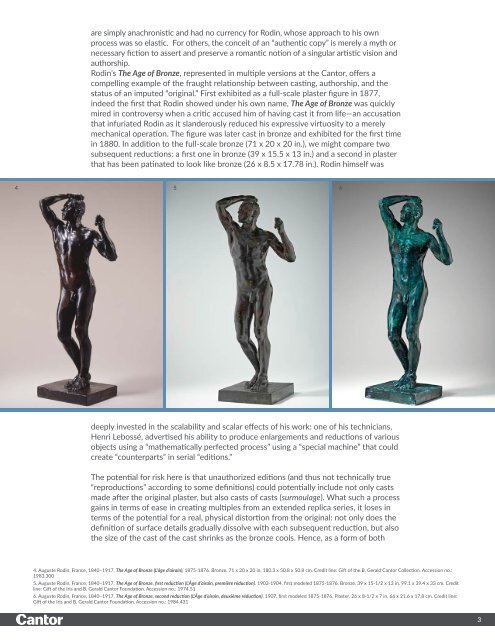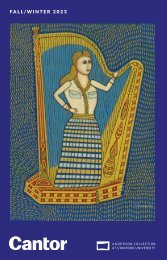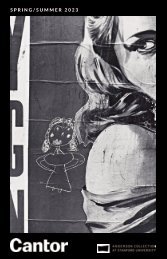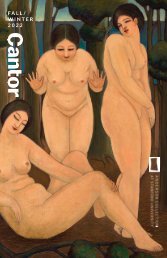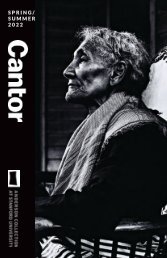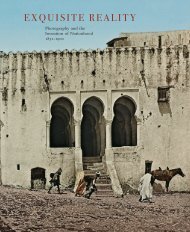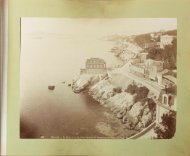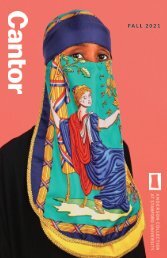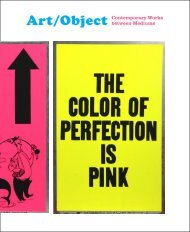Learning Guide | Recasting Rodin
It would hardly be an exaggeration to say that Auguste Rodin (1840–1917) forever changed the history of sculpture. Rarely had the medium so audaciously challenged the primacy of painting over the course of the nineteenth century. Long regarded as a “dead” medium of motionless, inert material, sculpture in Rodin’s nimble hands comes alive, breaking free of the plinths that traditionally separated sculpted figures in stone or metal from their earthbound beholders in flesh and blood. Patrick R. Crowley, PhD Associate Curator, European Art Cantor Arts Center
It would hardly be an exaggeration to say that Auguste Rodin (1840–1917) forever changed the history of sculpture. Rarely had the medium so audaciously challenged the primacy of painting over the course of the nineteenth century. Long regarded as a “dead” medium of motionless, inert material, sculpture in Rodin’s nimble hands comes alive, breaking free of the plinths that traditionally separated sculpted figures in stone or metal from their earthbound beholders in flesh and blood.
Patrick R. Crowley, PhD
Associate Curator, European Art
Cantor Arts Center
Create successful ePaper yourself
Turn your PDF publications into a flip-book with our unique Google optimized e-Paper software.
are simply anachronistic and had no currency for <strong>Rodin</strong>, whose approach to his own<br />
process was so elastic. For others, the conceit of an “authentic copy” is merely a myth or<br />
necessary fiction to assert and preserve a romantic notion of a singular artistic vision and<br />
authorship.<br />
<strong>Rodin</strong>’s The Age of Bronze, represented in multiple versions at the Cantor, offers a<br />
compelling example of the fraught relationship between casting, authorship, and the<br />
status of an imputed “original.” First exhibited as a full-scale plaster figure in 1877,<br />
indeed the first that <strong>Rodin</strong> showed under his own name, The Age of Bronze was quickly<br />
mired in controversy when a critic accused him of having cast it from life—an accusation<br />
that infuriated <strong>Rodin</strong> as it slanderously reduced his expressive virtuosity to a merely<br />
mechanical operation. The figure was later cast in bronze and exhibited for the first time<br />
in 1880. In addition to the full-scale bronze (71 x 20 x 20 in.), we might compare two<br />
subsequent reductions: a first one in bronze (39 x 15.5 x 13 in.) and a second in plaster<br />
that has been patinated to look like bronze (26 x 8.5 x 17.78 in.). <strong>Rodin</strong> himself was<br />
4 5 6<br />
deeply invested in the scalability and scalar effects of his work: one of his technicians,<br />
Henri Lebossé, advertised his ability to produce enlargements and reductions of various<br />
objects using a “mathematically perfected process” using a “special machine” that could<br />
create “counterparts” in serial “editions.”<br />
The potential for risk here is that unauthorized editions (and thus not technically true<br />
“reproductions” according to some definitions) could potentially include not only casts<br />
made after the original plaster, but also casts of casts (surmoulage). What such a process<br />
gains in terms of ease in creating multiples from an extended replica series, it loses in<br />
terms of the potential for a real, physical distortion from the original: not only does the<br />
definition of surface details gradually dissolve with each subsequent reduction, but also<br />
the size of the cast of the cast shrinks as the bronze cools. Hence, as a form of both<br />
4. Auguste <strong>Rodin</strong>, France, 1840–1917. The Age of Bronze (L’âge d’airain), 1875-1876. Bronze. 71 x 20 x 20 in. 180.3 x 50.8 x 50.8 cm. Credit line: Gift of the B. Gerald Cantor Collection. Accession no.:<br />
1983.300<br />
5. Auguste <strong>Rodin</strong>, France, 1840–1917. The Age of Bronze, first reduction (L’Âge d’airain, première réduction). 1903-1904, first modeled 1875-1876. Bronze. 39 x 15-1/2 x 13 in. 99.1 x 39.4 x 33 cm. Credit<br />
line: Gift of the Iris and B. Gerald Cantor Foundation. Accession no.: 1974.51<br />
6. Auguste <strong>Rodin</strong>, France, 1840–1917. The Age of Bronze, second reduction (L’Âge d’airain, deuxième réduction). 1907, first modeled 1875-1876. Plaster. 26 x 8-1/2 x 7 in. 66 x 21.6 x 17.8 cm. Credit line:<br />
Gift of the Iris and B. Gerald Cantor Foundation. Accession no.: 1984.431<br />
3


